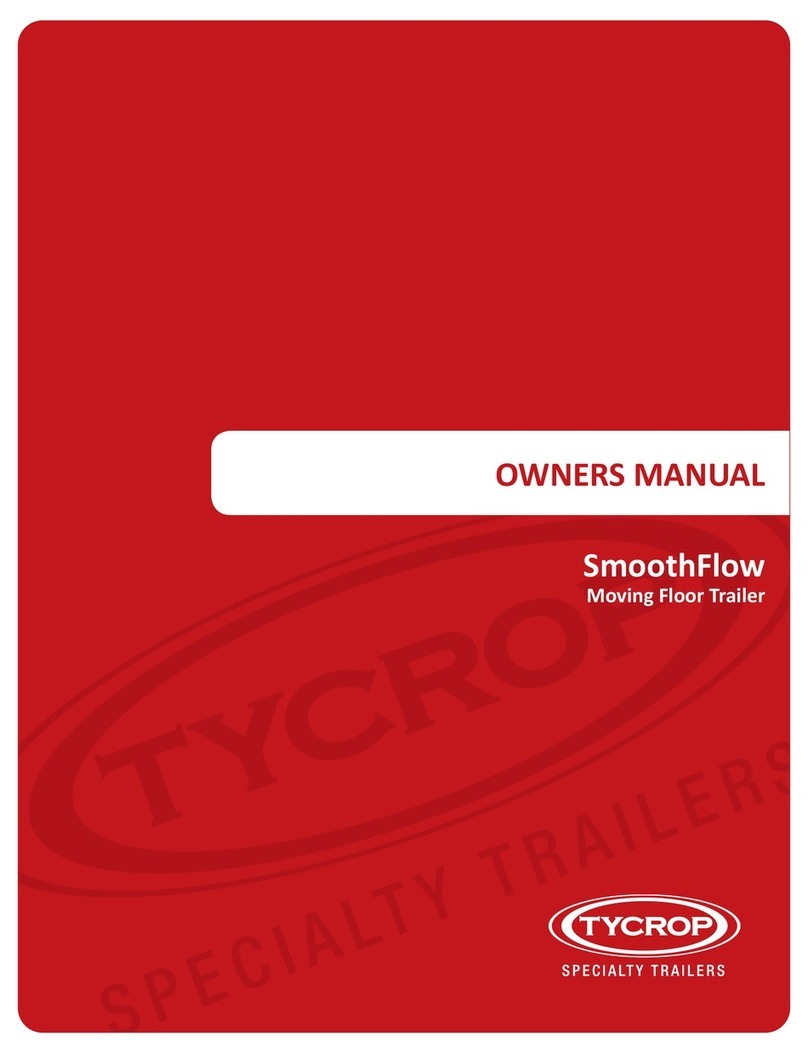
Operator’s Manual | Moving Floor Trailer 5
One Year Warranty
Manufacturer’s Responsibility
TYCROP Manufacturing Ltd. (On behalf of TYCROP Trailers)
warrants each item of its own manufacture to be free from
defects in material or workmanship. Should any part be
found under normal use and service to be defective, the
Manufacturer will repair or replace said parts, F.O.B. Factory.
This is provided said parts are returned to the Manufacturer’s
plant (freight pre-paid) and that such parts are judged by the
Manufacturer to be defective.
Warranty Start Date
The starting date shall be determined as that date shown on
the Invoice or Bill of Sale entered into at time of sale to the
owner.
Labour Consideration
If TYCROP Manufacturing Ltd., in its sole discretion,
determined that a repair facility other than the factory shall
perform the warranty work, TYCROP will pay a specified
labour amount for repair or replacement as determined and
approved by TYCROP, before any such work has started.
Components by Other Manufacturers
TYCROP Manufacturing Ltd. does not warranty items, parts
or machinery furnished by it but not of its own manufacture,
except for any warranties extended by the manufacturer of
such parts or machinery.
Product Owner Responsibilities
Owner is solely responsible for pre-operation inspection, daily
inspections, periodic inspections, maintenance and use of the
product in accordance with government requirements and
manufacturer’s specifications as established at the time of
manufacture.
Owner is responsible for communication expenses, meals,
lodging and incidental costs incurred by owner or employees
of the owner as a result of warrantable failure.
Owner is responsible for “down time” expenses, cargo
damage, and all business costs and losses resulting from a
warrantable failure.
Owner is responsible to provide TYCROP Manufacturing Ltd.
with accurate information, concerning the specification of a
particular piece of equipment, and accurate details on the
environment it will operate in. The owner is required to approve
the final design of the piece of equipment, and its suitability for
a particular application.
One Year Warranty
Special Order Equipment
Owner is responsible to provide TYCROP Manufacturing Ltd.
with accurate information concerning accurate specification
of a particular piece of equipment, and accurate details on
the environment it will operate in. The owner is required to
approve the final design of the piece of equipment, and its
suitability for a particular application. A statement of vehicle or
machine usage is included with this documentation.
Additional Warranty Limitation
The foregoing warranty does not apply to equipment that has
been altered, changed, or repaired in any manner whatsoever.
The above mentioned warranty is void in all respects when in
the manufacturer’s judgment the equipment has been subject
to misuse, negligence, or accident, or used for an application
other than outlined in the Statement of Machine Usage without
prior approval of the manufacturer.
These warranties are the sole warranties of TYCROP
Manufacturing Ltd. There are no other warranties expressed or
implied.
Warranty Claim Procedures
Claims can be made by phoning TYCROP Trailers at
1.800.663.2393.
For a claim to be considered, it must contain adequate
documentation which states vehicle mileage, the starting date
and the trailer or product serial number.
Note: Absolutely no claims will be considered unless the repair
has been approved and a TYCROP claim number assigned
before the repair is initiated.




























